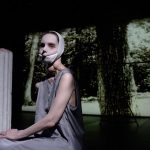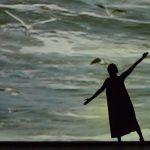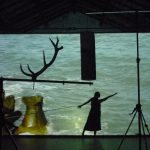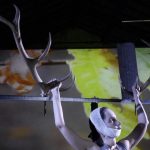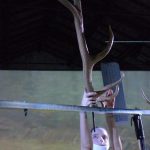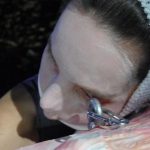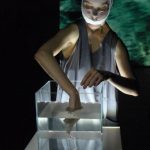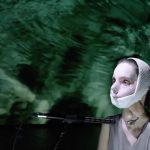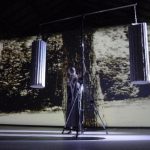
Iphigenia in the Taurides (Iphigenia in Taurus)
Iphigenia
2018-2019 Biennial Project
Scenic musical Diptych on the sacrifice of the innocent females
Creations by Maria Federica Maestri and Francesco Pititto
2018 IPHIGENE IN THE COURTS
Ah! how sweet he is, but it is difficult (Ah! Sweet, yet how difficult it is)
from Euripides and Gluck
2019 Iphigenia in Taurus
I am mute
(I am mute)
from Goethe and Gluck
In this new creative process – second chapter of the diptych dedicated to the myth of Iphigenia – the scenic installation and the direction by Maria Federica Maestri as well as the imagery by Francesco Pititto are inspired by Joseph Beuys’s historic action Titus-Iphigenia of 1969.
Interpreting Iphigenia in Taurus. I am mute will be Monica Barone, a dancer whose performative sensitivity has matured in the relationship with her own physical specificity. Monica was born with a severe facial malformation, and, despite the numerous surgical operations she is often subjected to, this condition does not prevent her from cultivating and practicing with passion the languages of contemporary dance and photography.
She recently played the role of Beatrice in the large site-specific installation Paradise. A Sacred Piece. By Lenz (2017).
Iphigenia in Taurus. I am mute | I am mute is the second part of a diptych created by Maria Federica Maestri and Francesco Pititto from the myth of Iphigenia. The interpreter is Monica Barone, a dancer with great performative sensitivity matured in a deep and conscious relationship with her own physical specificity. Iphigenia in Taurus is the result of a triple inspiration: the drama of Goethe Iphigenia in Tauris (1787), the work of Gluck Iphigenia in Tauride (1779) and the historic action of Joseph Beuys Titus Iphigenia, which took place in Frankfurt in 1969.
At the center of the scenic area, suspended between the metal branches of mechanical plants, in a sharply autobiographical mirroring, the horns of the immolated deer stand out and laughtered in place of the young one. On the proscenium stands a small altar, a cold steel chopping board, on which a washing cube is placed to perform purification rituals: on that altar, disobeying laws that she considers unjust and inhuman, Iphigenia will not sacrifice any victim, will not perform any human sacrifice, but with an intimate and secret rite will implore the gods to return free and to be happy. In front of their silence, confused and anguished, she decides to dare a bold action and conquer a new homeland-body, free from social and religious ties.
Symbols, rituals, autobiographical actions of Joseph Beuys’ powerful 1969 performance Titus-Iphigenia were inspirational for Lenz’s Iphigenia in Taurus. The biography of the perfomer – Monica Barone – has become aesthetic material for an action that makes public her physical condition, her state, her powerful will to transform her intimate gesture into redemption from the divine imposition, of liberation from the political order. In opposition to the violence of Titus Andronicus for Beuys and that of the ferocious Toante, tyrant of Tauris, in Goethe’s Iphigenie in Tauris Iphigenia’s new real and conceptual gestures become the act of rebellion and revolt against social conventions and norms.
It is still the biography that moves the body and life gives shape to the movement: Pina Bausch’s Tanztheater has marked the choreographic language; the biographies of the dancers were essential to the “dance composer”, as Bausch liked to define herself, to outline emotional states, gestures and movements, colors and musical writings in each work. Monica, motivated by a profound existential need, but in particular for this Iphigenia, brings herself and her own life to the stage, performing a contemporary ritual beyond word, beyond gesture, to be free to rewrite her own history, to “transform the world”, Beuys would have said.
LENZ FONDAZIONE Lenz’s contemporary performative creation projects are the artistic result of a complex work of visual, filmic, spatial, dramaturgical and sound research. In an aesthetic convergence between exegetical loyalty to the word of the text, visual radicality of filmic creation, originality and conceptual extremism of the artistic installation, Lenz’s work rewrites philosophical tensions in visionary signs and aesthetic concerns of the contemporary world.
MONICA BARONE was born in Caracas in 1972. Despite the numerous face surgery to which she has had to undergo since her early childhood, she practices contemporary dance and photography with discipline and passion. She recently was Beatrice’s interpreter in the large site specific Lenz’s installation Paradiso. A Sacred Piece (2017).
Iphigenia in the Taurides
I am mute (I am mute)
from Johann Wolfgang Goethe and Christoph Willibald Gluck
with the patronage of Goethe-Institut Mailand
Dramaturgy and imagery | Francesco Pititto
Theatrical scenery, direction, costumes | Maria Federica Masters
Performer | Monica Barone
Choreographic notation | David Rocchi
Technical manager | Alice Scartapacchio
Project manager | Elena Sorbi
Organization | Ilaria Stocchi
Production and International promotion | Loredana Scianna
Press office and communication | Michele Pascarella
Media Video | Doruntina Film
Assistant | Marco Cavellini
Production | Lenz Foundation 2019
Running | 45’
With a vigorous lighting of gaze, Maestri and Pititto trace in a single interpreter a geography of absolute passions, not determinable in a historical time, returning to an essential dance of gestures its ritual dimension.
Giuseppe Distefano, Exibart
If the energy of the actor, and of the shaman-actor, has to do with non-daily psychophysical states, here we have the epiphany of bodies that that energy spontaneously embody and are therefore able to theatrically shock the viewer with the pure strength of presence alone, naturally disciplined and modeled on stage by the relationship with the director Maria Federica Maestri.
Franco Acquaviva, Curtain







